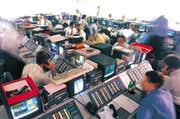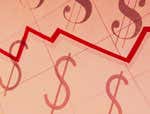When: March 11, 2000 to October 9, 2002
Where: Silicon Valley (for the most part)
How Much: The Nasdaq Composite lost 78% of its value as it fell from 5046.86 to 1114.11. (Related: Why did dotcom companies crash so drastically?)
Back When the Internet Was New
Decades before the word "dotcom" slipped past our lips as the answer to all of our problems, the internet was created by the U.S. military, who vastly underestimated how much people would want to be online. Commercially the internet started to catch on in 1995 with an estimated 18 million users. The rise in usage meant an untapped market - an international market. Soon, speculators were barely able to control their excitement over the "new economy."
Companies underwent a similar phenomenon to the one that gripped Seventeenth century England and America in the early eighties: investors wanted big ideas more than a solid business plan. Buzzwords like networking, new paradigm, information technologies, internet, consumer-driven navigation, tailored web experience and many more examples of empty double-speak filled the media and investors with a rabid hunger for more. The IPOs of internet companies emerged with ferocity and frequency, sweeping the nation up in euphoria. Investors were blindly grabbing every new issue without even looking at a business plan to find out, for example, how long the company would take before making a profit, if ever.
Analyst Capture and the End of Free Cash
Obviously, there was a problem. The first shots through this bubble came from the companies themselves: many reported huge losses and some folded outright within months of their offering. Siliconaires were moving out of $4 million estates and back to the room above their parents' garage. In the year 1999, there were 457 IPOs, most of which were internet and technology related. Of those 457 IPOs, 117 doubled in price on the first day of trading. In 2001 the number of IPOs dwindled to 76, and none of them doubled on the first day of trading.
Adding to the froth around dotcom companies, there was a clear trend of analysts being incredibly supportive despite a lack of anything but a back-of-the-napkin business models. This trend was most pronounced in analysts that were attached to the underwriting banks and issuing firms. When companies like Pets.com went under, analysts were slow to lower their buy ratings. As these cases multiplied, the dotcom bubble burst, turning into the dotcom crash.
Many argue that the dotcom boom and bust was a case of too much too fast. Companies that couldn't decide on their corporate creed were given millions of dollars and told to grow to Microsoft size by tomorrow. When it became clear that most companies couldn't, much of the free cash coming from venture capitalists to take these companies public suddenly dried up. A lot of ridiculous companies went under, but so did many companies that could have been viable in the right conditions. This purge set back some technologies in Silicon Valley back decades in addition to destroying a lot of capital in failed IPOs.
Speculation Without a Pesky IPO
Like the excitement over Asia leading to a bubble and crash that delayed the actual emergence of the region, the dotcom bubble set the tech industry back years. Now, however, we've all learned our lessons and we never bid up a tech company to ridiculous P/E multiples. Well, unless it is a social media company. Or a sharing economy company. Or a player in virtual reality. Oh, and there is that other bubble where private capital delays the IPO indefinitely, allowing the term Unicorn to enter the financial lexicon. So maybe, just maybe, tech isn't done with bubbles yet.
Market Crashes: Housing Bubble and Credit Crisis (2007-2009)
-
 Financial Advisor
Financial AdvisorIs the Stock Market Crashing? 5 Signs to Consider
Learn about some signs of a potential stock market crash including a high level of margin debt, lots of IPOs, M&A activity and technical factors. -
 Investing
InvestingEconomic Bubble: Toil And Trouble!
You might like the idea of profiting from a bubble, but you’d probably like to avoid suffering from its aftermath. Here is how an economic bubble works. -
 Insights
InsightsHow Do Asset Bubbles Cause Recessions?
Understand how asset bubbles often lead to deep, protracted recessions. Read about historical examples of recessions preceded by asset bubbles. -
 Insights
InsightsFive Of The Largest Asset Bubbles In History
The five bubbles discussed here were among the biggest in history; their lessons should be heeded. -
 Insights
InsightsSome Industries Are More Bubbly Than Others
Investors who want to avoid future bubbles should learn from the past in order to protect their investments. -
 Insights
Insights5 Ways To Spot The Next Stock Bubble - And Avoid It
Playing a market bubble could pay off, but it carries a lot of risk. Avoiding it could be the way to stay profitable. -
 Insights
Insights5 Steps Of A Bubble
Bubbles are deceptive and unpredictable, but by studying their history we can prepare to our best ability. -
 Investing
InvestingWhere Will the Shanghai Composite Be in a Year?
The Shanghai Composite Index is on fire. But where will it be a year from now? -
 Investing
Investing4 Ways to Survive a Stock Market Bubble
As stocks soar to new records, and fears of a bursting bubble mount, it's time for defensive measures.



